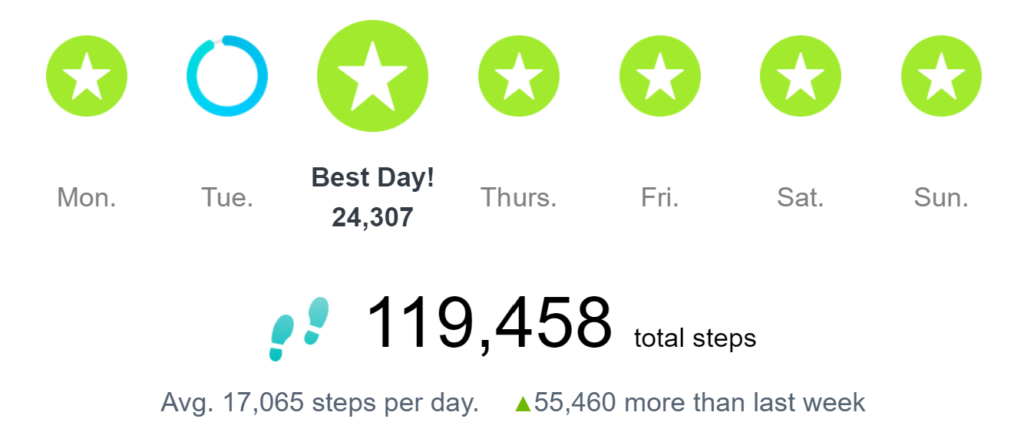On a recent hiking trip, I averaged over 17,000 steps per day. I suspect we’ve all heard of the 10,000 steps per day recommendation for health, but where did that number come from? Last, what does current evidence suggest about 10,000 daily steps as the goal for a healthy lifestyle? Let’s explore.
Table of Contents:
- TL;DR (Too Long; Didn’t Read)
- Ok, but Why?
- Bonus: The 100,000 Step Challenge
- Reader Questions
- References
TL;DR
- Daily step count is a proxy for overall activity level
- Higher activity levels correlate with lower risk and rates of disease
- Data from the All of Us research program suggests at least 8,200 steps per day was associated with a lower risk of certain chronic health conditions such as obesity, type 2 diabetes, and hypertension, among others
- Some suggestions to get more steps include:
- Walking after every meal (e.g., 10 minutes)
- Walking to the furthest bathroom
- Taking walking meetings/calls
- Getting a walking desk
Ok, but Why?
Where Did the 10,000 Steps/Day Recommendation Originate?
As with many facts and figures now ingrained in our psyche (and activity trackers), the 10,000 steps per day goal did not originate from science. Rather, it was a marketing tool for a Japanese pedometer manufacturer who introduced a device in the 1960’s called the “manpo-kei”, which roughly translates to “10,000 steps meter.”

Whether it was the memorability of 10,000 as a nice, round number or another reason, it quickly became the measure for the ideal amount of daily activity. It wasn’t until 2006 that the Japanese government formalized the recommendation for “a daily walk of 8,000 to 10,000 steps” as the target to promote health.1
Note: while the above history is perhaps wildly deviant from the topic at hand, it is worth speculating about the impact and effectiveness of these marketing-slogans-turned-government-recommendations, particularly given Japan’s status as one of the healthiest, longest-lived countries in the world. My suspicion is the specificity and accessibility of such a recommendation make it concrete and actionable (“8,000 to 10,000 steps per day” is very intuitive). Compare this language to US governmental recommendations that are not easily understood by the general public (e.g., “150 to 300 minutes a week of moderate-intensity, or 75 to 150 minutes a week of vigorous-intensity aerobic physical activity).2 But I digress…
The power of marketing at work!
What Does Step Count Have to Do with Health?
Step count is a proxy for overall physical activity, and higher levels of physical activity have been correlated with a lower risk of developing certain conditions and diseases such as diabetes, hypertension (high blood pressure), obesity, and others.
Additionally, but acknowledging there are rare conditions that sadly prevent it, walking is intrinsic to humans, which makes it an almost mindless form of physical activity compared to, say, lifting weights. Finally, walking is low-intensity and low-impact but it can be modified or intensified by changing the direction (e.g., forward, backward, sideways), speed or incline, making it a versatile form of exercise.
What Does Current Evidence Suggest?
Perhaps the first and most important point to understand about guidelines or recommendations such as 10,000 steps per day is that, in reality, it is not that binary. In other words, it is not accurate to conclude that 10,000 steps or more per day is healthy and anything less is not.
These kinds of metrics and their impact on outcomes like disease should be viewed more on a spectrum. As an example, more helpful questions to answer are ones such as: “is 10,000 steps better than 8,000 steps?” or “is 8,000 steps better than 6,000 steps?” or “at what point does the number of steps stop making a difference in terms of disease risk?”
As an example of a recent study that looked to answer these questions, researchers analyzed data from the All of Us database to determine the association of step count with the risk of chronic disease, specifically obesity, type 2 diabetes, hypertension, gastroesophageal reflux disease (GERD), sleep apnea, and major depressive disorder (MDD).3 What they found in this specific cohort, which admittedly skewed largely young, white, college-educated, and female, was that daily step counts in the 8,000-9,000 range were associated with a reduced risk of these conditions.
“These results suggest that a single step count target of approximately 8,000-9,000 steps per day may be suitable to reduce risk of many common conditions.”
Additionally, for some of the conditions, there was no further risk reduction above 8,000-9,000 steps.
Translation: the higher the step count, the better, especially up to 8,000-9,000 steps per day.
Practical Tips on How to Meet the Daily Recommended Step Count
To make this recommendation more practical, let’s consider that 1 mile equates to roughly 2,000-2,500 steps, depending on height and stride length. This would suggest that to meet the daily recommended step count somewhere in the 8,000 step range, we would have to walk 3-4 miles.
For round numbers, let’s also consider that the average walking pace is about 3 miles per hour. As such, we would need to dedicate anywhere from 60-80 minutes per day to walking to achieve the recommended daily step count.
| Distance | Steps | Time |
| 1 mile | 2,000-2,500 | ~20 minutes |
| 2 miles | 4,000-5,000 | ~40 minutes |
| 3 miles | 6,000-7,500 | ~60 minutes |
| 4 miles | 8,000-10,000 | ~80 minutes |
With jobs, kids, and other responsibilities, finding an hour-plus every day to walk might be a challenge, particularly if we think about it as a single bout. But it doesn’t necessarily have to be. Here are some alternative ways to incorporate walking into our busy day/lives:
- Walk for 10 minutes after every meal
- Not only are you getting steps in, but walking immediately after a meal has been shown to help regulate the blood sugar response to the meal.4
- Walk to a bathroom further/furthest away
- When I was working in an office setting, having to get up and walk more than 30 feet to the bathroom was standard practice. Whether you can replicate this at home (e.g., using the downstairs bathroom if you’re upstairs, or vice versa), or work in an office setting, this modification is a low-hurdle chance to get some more steps in.
- Take a walking meeting/call
- Challenge yourself to take one walking meeting per day if possible. Ideally this would be one where you don’t have to be presenting or looking at a presentation on your phone.
- Get a walking desk
- While this is likely an investment, it may be especially practical for those like me who work from home. Walking for 60-80 minutes out of the 8-hour workday seems far more achievable than trying to fit that time in during non-working hours.
Bonus: The 100,000 Step Challenge
All this marketing and math got me thinking about another nice, round number. Over the course of the week, I racked up over 100,000 steps. So I got to wondering (like a crazy person): would 100,000 steps in a day be feasible??? If we follow the above math, 100,000 steps would be between 40-50 miles. Stay tuned (or not) to find out.

Reader Questions
- What other activities do you do to get your steps in?
- Have you seen other papers or articles that recommend a different daily step count?
- Has anyone ever achieved 100,000 steps in a single day?
References:
- https://www.nibiohn.go.jp/eiken/english/research/program_exercise_epar2006.html
- https://health.gov/our-work/nutrition-physical-activity/physical-activity-guidelines/current-guidelines
- Master, H., Annis, J., Huang, S. et al. Association of step counts over time with the risk of chronic disease in the All of Us Research Program. Nat Med 28, 2301–2308 (2022). https://doi.org/10.1038/s41591-022-02012-w
- Bellini A, Nicolò A, Bazzucchi I, Sacchetti M. The Effects of Postprandial Walking on the Glucose Response after Meals with Different Characteristics. Nutrients. 2022 Mar 4;14(5):1080. doi: 10.3390/nu14051080. PMID: 35268055; PMCID: PMC8912639.
